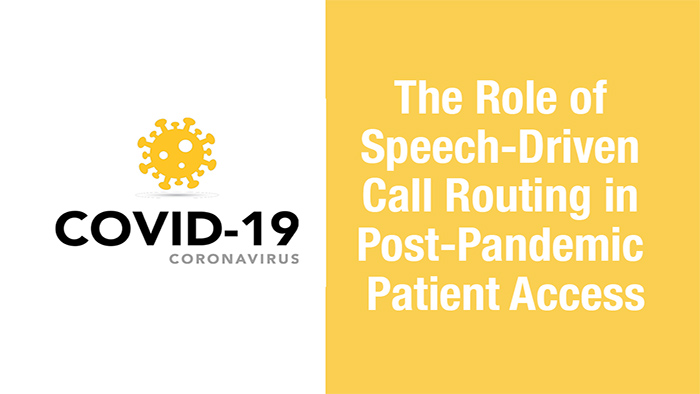During the COVID-19 pandemic, patient access contact centers across the country had to condense years of healthcare industry technological development into just one year. Now that we’ve overcome the chaos we encountered at the beginning of the pandemic, we must readjust to new patient experience realities, which may include fluctuating call volumes and surges in patient access needs and support.
How can health systems balance between automated self-service and live agent support? How can they also improve efficiency in contact center operations—removing barriers and friction from the caller journey, guaranteeing a positive patient experience, and improving agent experience as well?
In the post-pandemic era, there is significant evidence demonstrating the importance of utilizing AI to improve call routing in order to address rising consumerism and the increased expectations of patients.
Consumer expectations in retail and hospitality are no different than those of patients. These are 3 examples of AI and speech-enabled call routing improved caller experience and operations in other industries and how it relates to healthcare consumers.
- Reduce hold times – When customer demand spiked for Amazon during the pandemic, their consumers and employees began to feel the effects from it. Customers were waiting on hold for long periods of time and employees felt they had no time when answering calls, preventing them from helping people with more complex issues. Amazon leveraged AI and speech-enabled call routing to help with this issue, directing consumers with simple needs to self-serve and consumers with more complex needs to a live agent. These same effects of the pandemic were felt by patients and employees in healthcare. Speech-enabled call routing allows patients who know what they want to get there without any difficulty, and patients who don’t, can speak to someone without having to wait on hold for a long time. Amazon knows they need to reduce effort for their customers. Patients expect and deserve the same, easy, friction-free experiences. (https://aws.amazon.com/blogs/contact-center/how-covid-19-has-changed-the-way-customer-service-leaders-think-about-contact-centers/)
- Connect people quickly and accurately – During and after the pandemic, ordering take-out became increasingly popular. Pizza Hut Australia was struggling to route calls to stores closest to the customer calling. People were becoming frustrated, complaining about always being transferred to the wrong location. By introducing speech recognition technology into their process, they were able to accurately transfer customers to the correct location, drastically improving the customer experience. For the healthcare industry, patient calls and concerns also increased due to the pandemic. And like those customers ordering take-out pizza, patients don’t want to be repeatedly transferred to the wrong department or person—they want a seamless experience that brings them exactly where they need to be, quickly and efficiently. (https://venturebeat.com/2021/07/14/pizza-hut-demonstrates-why-intelligent-virtual-agents-are-the-future-of-customer-service/ )
- Reduce call volume for contact centers – Before the pandemic, a start-up hotel company, Sonder, created an almost entirely contactless experience – from check-in to check-out, practically every step was done digitally. However, when the pandemic started, they ran into unexpected issues with customer concerns. One of their principal goals was for customers to be able to resolve any issues as easily as they could. To do this, they improved their speech-driven call routing system to quickly solve concerns and lighten call volume for their call center agents. Guests could now be connected to the most accurate representative for their situation without having to go through a long IVR menu. Not only did the pandemic increase customer concerns in hospitality, but especially in healthcare, with the same issue of overwhelmed contact centers. With speech enabled call routing, customers and patients can easily solve their issues by speaking with agents who are receptive and not under high levels of stress. Just as guests at a hotel want the five-star customer experience, healthcare consumers want it at that same level. (https://www.forbes.com/sites/salesforce/2021/02/08/pandemic-pivot-how-hospitality-start-up-sonder-finds-success-during-covid/?sh=11c950df591b)
Speech-enabled call routing provides switchboards and contact centers with greater capacity to adapt to call volume surges. Patient experience improves when callers are able to get to the person or department they need, quickly and efficiently, without long hold times. Agents and operators are under less stress when routine callers can self-serve. By removing calls that are unnecessary, call queues are reduced and support teams have more time to solve complex issues for patients.
Parlance is a Software as a Service company leveraging speech recognition technology to improve the caller experience for leading organizations nationwide. Hundreds of health systems, higher education institutions, and enterprises rely on Parlance every day to modernize call handling and call routing, minimize caller effort and reduce operational costs.
Health systems specifically subscribe to Parlance to enable their patients to speak naturally and connect directly when they call on the phone. Parlance is the only company to deliver speech recognition as a fully managed service. We provide not only industry-leading technology, but a team of tenured experts who make your system work, take ownership of day-to-day performance, and guarantee ROI. No complicated fees, no extra charges, and no long contracts required. At Parlance you don’t buy software, you subscribe to results.
By Amy Murphy




